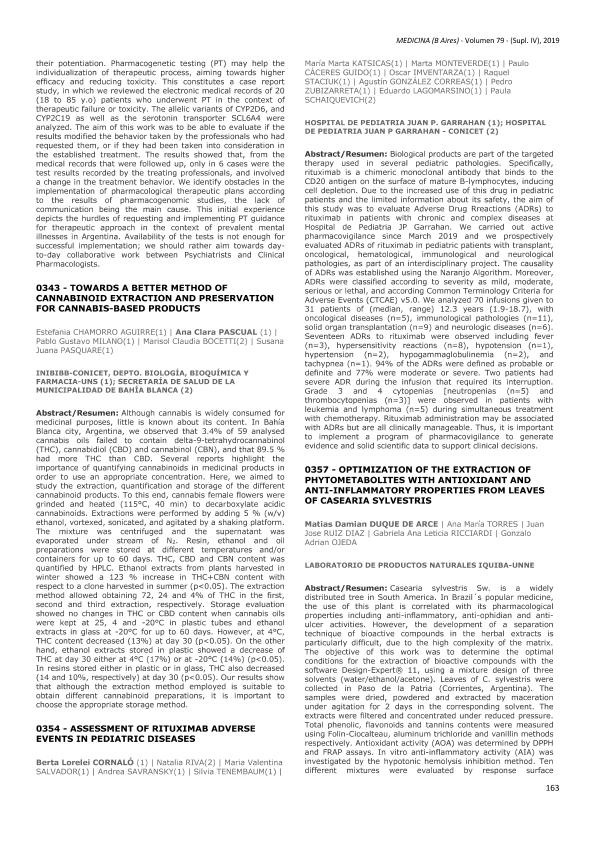Evento
Towards a better method of cannabinoid extraction and preservation for cannabis-based products
Chamorro Aguirre, Estefania ; Pascual, Ana Clara
; Pascual, Ana Clara ; Milano, Pablo Gustavo
; Milano, Pablo Gustavo ; Bocetti, Marisol Claudia; Pasquaré, Susana Juana
; Bocetti, Marisol Claudia; Pasquaré, Susana Juana
 ; Pascual, Ana Clara
; Pascual, Ana Clara ; Milano, Pablo Gustavo
; Milano, Pablo Gustavo ; Bocetti, Marisol Claudia; Pasquaré, Susana Juana
; Bocetti, Marisol Claudia; Pasquaré, Susana Juana
Tipo del evento:
Reunión
Nombre del evento:
LXIV Reunión Anual de la Sociedad Argentina de Investigación Clínica; LI Reunión Anual de la Asociación Argentina de Farmacología Experimenta; XXI Reunión Anual de la Sociedad Argentina de Biología; XXXI Reunión Anual de la Sociedad Argentina de Protozoología; IX Reunión Anual de la Asociación Argentina de Nanomedicinas y VI Reunión Científica Regional de la Asociación Argentina de Ciencia y Tecnología de Animales de Laboratorio
Fecha del evento:
13/11/2019
Institución Organizadora:
Sociedad Argentina de Investigación Clínica;
Asociación Argentina de Farmacología Experimental;
Sociedad Argentina de Biología;
Asociación Argentina de Nanomedicinas;
Título de la revista:
Medicina (Buenos Aires)
Editorial:
Fundación Revista Medicina
ISSN:
0025-7680
e-ISSN:
1669-9106
Idioma:
Inglés
Clasificación temática:
Resumen
Recombinant human erythropoietin (Epo) has been successful in the treatment of anemia of different etiologies but high Epo doses, used to reduce the frequency of administration or to treat refractory anemia, have been linked with adverse outcomes. Previously, we observed a decreased effect of high Epo concentrations on endothelial cell migration. Here, we studied the antiapoptotic effect of Epo on erythroleukemia K562 cells exposed to TNF-a (T), after incubation with increasing concentrations of Epo (10, 100 and 400 U/mL) and erythroid differentiation with hemin. While Epo10 prevented the increase in the percentage of apoptotic nuclei observed with TNF-a, Epo100 and Epo400 did not show that protection. Considering that this effect could be related to the decreased availability of the Epo receptor, we investigated the activity of protein tyrosine phosphatase 1B (PTP1B) and the process of proteasomal degradation in this cell model. PTP1B activity, which regulates many aspects of the signaling pathways elicited by Epo upon EpoR activation, showed no significant differences between cultures with low and high Epo concentrations. Then, we used the proteasome inhibitor MG132 to evaluate if EpoR internalization could affect the antiapoptotic effect of Epo against TNF-a. In the presence of MG132, the results with high concentrations of Epo were similar to those observed with Epo10T (Hoechst staining, C 13.5 ± 0.7, T 31.5 ± 1.5*, Epo10T 22.1 ± 1.1*, Epo100T 29.4 ± 1.4*, Epo400T 29.9 ± 2.2*, Epo100TMG 21.7 ± 19, and Epo400TMG 22 ± 1.3 %, *P<0.05, n= 6). Based on this, it can be suggested that the kinetics of EpoR internalization/degradation, mediated by the proteasome, could explain, at least in part, the lack of antiapoptotic effect of high concentrations of Epo. The present results give new insights that may contribute to understand Epo behavior when cells of different tissues are activated by a high concentration of the hormone, and may help to adequate therapeutic strategies.
Palabras clave:
DELTA-9-TETRAHYDROCANNABINOL
,
CANNABIDIOL
,
EXTRACTION
,
QUANTIFICATION
,
STORAGE
Archivos asociados
Licencia
Identificadores
Colecciones
Eventos(INIBIBB)
Eventos de INST.DE INVEST.BIOQUIMICAS BAHIA BLANCA (I)
Eventos de INST.DE INVEST.BIOQUIMICAS BAHIA BLANCA (I)
Citación
Towards a better method of cannabinoid extraction and preservation for cannabis-based products; LXIV Reunión Anual de la Sociedad Argentina de Investigación Clínica; LI Reunión Anual de la Asociación Argentina de Farmacología Experimenta; XXI Reunión Anual de la Sociedad Argentina de Biología; XXXI Reunión Anual de la Sociedad Argentina de Protozoología; IX Reunión Anual de la Asociación Argentina de Nanomedicinas y VI Reunión Científica Regional de la Asociación Argentina de Ciencia y Tecnología de Animales de Laboratorio; Mar del Plata; Argentina; 2019; 163-163
Compartir



